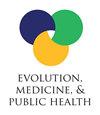艰苦季节血红蛋白低与玻利维亚高原妇女排卵机会减少有关
IF 2.1
3区 医学
Q2 EVOLUTIONARY BIOLOGY
引用次数: 0
摘要
背景和目的 女性生殖功能可灵活应对能量供应的生态变化,但对铁等其他生态有限资源的作用仍知之甚少。本分析调查了生活在玻利维亚高原的农村自然生育人群中的血红蛋白是否与生殖功能投资有关。方法 我们对前瞻性收集的生物标志物和社会人口学数据进行了横断面二次分析,这些数据包括生活在海拔 3800 米地区的 96 名未避孕妇女的 152 个月经周期。采用多变量多层次模型研究:(1) 血红蛋白浓度是否与生存策略和季节条件的生态变化有关;(2) 血红蛋白浓度是否与排卵发生率和/或黄体孕酮浓度(当前生殖投资的两个生物标志物)有关。结果 在较为依赖传统农牧业生存策略的妇女中,血红蛋白浓度在艰苦季节较低(β = -0.42,95% CI:-0.80 至 -0.04,p = 0.032)。在更艰苦的季节,血红蛋白每增加 1 个标准差,排卵几率就会增加 3 倍多(调整后的几率比 = 3.27,95% CI:1.10 至 9.27,p = 0.033)。结论与启示 在条件相对恶劣且有望改善的情况下,血红蛋白水平低与当前生殖投资减少和受精率降低有关。这些结果支持铁作为一种限制性资源在调节生殖权衡中的作用,而与能量储存无关。本文章由计算机程序翻译,如有差异,请以英文原文为准。
Low haemoglobin in arduous seasons is associated with reduced chance of ovulation among women living in the Bolivian altiplano
Background and objectives Female reproductive function flexibly responds to ecological variation in energy availability, but the roles of other ecologically limited resources, such as iron, remain poorly understood. This analysis investigates whether haemoglobin associates with investment in reproductive function in a rural natural fertility population living in the Bolivian altiplano. Methodology We conducted a cross-sectional secondary analysis of prospectively collected biomarker and sociodemographic data, comprising 152 menstrual cycles from 96 non-contracepting women living at 3800m altitude. Multivariable multilevel models were used to investigate (1) whether haemoglobin concentration is associated with ecological variation in subsistence strategy and seasonal conditions, and (2) whether haemoglobin concentration is associated with the occurrence of ovulation and/or the concentration of luteal progesterone, two biomarkers of current investment in reproduction. Results Haemoglobin concentrations were lower in arduous seasons among those women more dependent on traditional agropastoral subsistence strategies (β = -0.42, 95% CI: -0.80 to -0.04, p = 0.032). During more arduous seasons, a 1 standard deviation increase in haemoglobin was associated with an over 3-fold increase in the odds of ovulation after adjusting for body fat, breastfeeding status, and age (adjusted odds ratio = 3.27, 95% CI: 1.10 to 9.27, p = 0.033). Conclusions and implications When conditions are relatively harsh and may be expected to improve, low haemoglobin levels are associated with lower current investment in reproduction and reduced fecundity. These results support the role of iron, independent of energy stores, as a limiting resource in modulating reproductive trade-offs.
求助全文
通过发布文献求助,成功后即可免费获取论文全文。
去求助
来源期刊

Evolution, Medicine, and Public Health
Environmental Science-Health, Toxicology and Mutagenesis
CiteScore
5.40
自引率
2.70%
发文量
37
审稿时长
8 weeks
期刊介绍:
About the Journal
Founded by Stephen Stearns in 2013, Evolution, Medicine, and Public Health is an open access journal that publishes original, rigorous applications of evolutionary science to issues in medicine and public health. It aims to connect evolutionary biology with the health sciences to produce insights that may reduce suffering and save lives. Because evolutionary biology is a basic science that reaches across many disciplines, this journal is open to contributions on a broad range of topics.
 求助内容:
求助内容: 应助结果提醒方式:
应助结果提醒方式:


